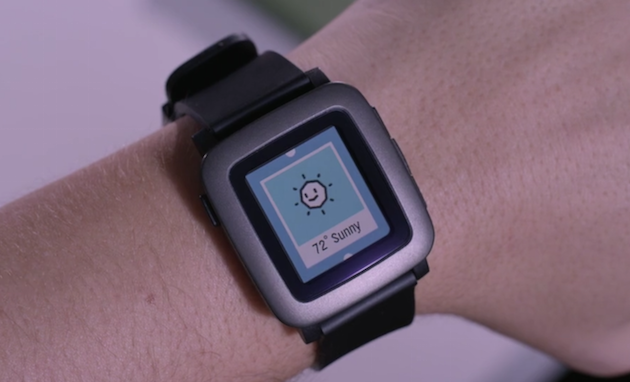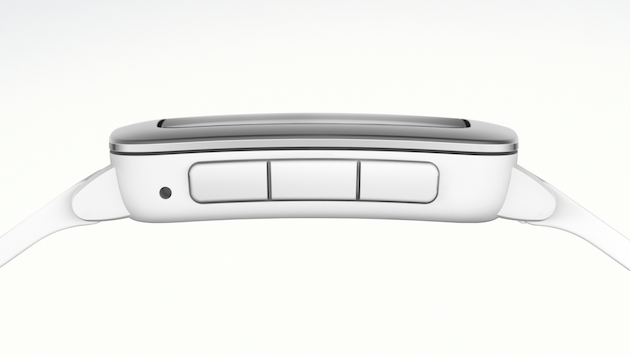Pebble returns to Kickstarter for its next-gen color smartwatch

Three years ago, Pebble made crowdfunding history by raising over $10 million on Kickstarter for its simple e-ink smartwatch -- a whole two years before Android Wear even existed. The company has rolled out some new designs and features since then, but despite growing competition from the likes of Google and Apple, the Pebble watch itself hasn't really changed. Until today. Say hello to the Pebble Time, the next-generation Pebble smartwatch. It has a color display, a slimmer design, a microphone and a whole new operating system. And it's making its debut on the platform that got it all started: Kickstarter.
Before we get into that, however, let's start with that color display -- yep, all those rumors and leaks about that are true. But, it's not just any color screen.
"We looked at all the different screen technology like LCD and OLED, and we tried all of the different watches that have them," says Eric Migicovsky, CEO and founder of Pebble. "It just wasn't doing it for us." In the end, he says, a smartwatch has to be a great watch. "We couldn't deal with the compromise of LCD or OLED. The battery life was poor; the watch screen would turn off; and you'd have to press a button to turn it back on."
So instead of OLED or LCD, Pebble went with e-paper. Specifically, color e-paper. This gives it two significant advantages: 1) The watch face can be always on all the time and 2) It has up to seven days of battery life, just like the original Pebble. During our chat, Migicovsky actually showed me a functioning Pebble Time, with an animating nyan cat in all its rainbow glory running on the watch. "It's 30 frames per second on an e-paper screen," he says.
The new Pebble Time is also smaller and thinner than the original Pebble -- 20 percent skinnier, in fact -- and the watch housing is ever so slightly curved to better fit the curvature of the wrist. It still has that square display, but the glass on the display is scratch-resistant Gorilla Glass; the bezel is stainless steel; and the rest is polycarbonate. As for the straps, it comes with a silicone band, but any standard 22mm band will work just fine. The Time even comes with a little quick-release toggle so that you can easily swap straps. And yes, it's just as water-resistant as the original.

Also, at long last, Pebble Time now has a microphone. But before you think it'll work with Google Now or Siri, think again. "We tried it with Android Wear," says Migicovsky. "But a lot of times it doesn't work that well. Sometimes it causes you more hassle than just pulling out your phone and typing stuff in."
So instead of an open-ended voice interface where you can ask anything, Pebble Time's voice feature is very focused on one thing: voice responses to incoming notifications. For example, when you get an email, you can select it and reply with your voice right then and there. That audio reply can be translated to text if you like, but you also have the option of just sending the audio file, which is good if you're in a noisy environment where voice-to-text won't work as well. Pebble Time also comes with a voice-note capability for quick, dictated notes.
If that sounds rather limited, well Pebble is also opening up the voice API to developers, so they can use the voice-response capability in their apps too. Later on, developers will also be able to add voice input into their apps as well. So someone could very well develop a digital assistant app like a Siri or a Google Now and have it work with Pebble Time.
But aside from these various hardware improvements, perhaps the biggest change of all is the new Pebble operating system. "The current way we deal with apps is to just put them in a list. Install more apps; add them to the list ... Once you install more than 10 to 15 apps, it gets really complex," says Migicovsky. "What we realized over the years, is that the metaphor for apps doesn't really translate to smartwatches."

Instead, Migicovsky and his team have come up with a whole new interface for smartwatches that's based around, well, time. Instead of apps siloing information so that you need to get in and out of an app to see it, it's now all relayed chronologically. That means all your notifications, reminders, events and news are laid out in order, from the "Past" to the "Future." So, for instance, rather than launching a weather app to check out the day's forecast, it will already be pinned on your timeline. You can scroll back to the Past to see what you've missed -- maybe last night's baseball score or yesterday's step count -- or skip to the Future to see what you have coming up.
As for the "Present"? That's basically where the new App Menu resides, and yes, you will still be able to launch apps just as before. Indeed, the Pebble Time and the new operating system are fully backward-compatible with all 6,500-plus apps in the Pebble store. There's also a new feature called App Faces, which are essentially widgets that tell you what's happening right now without having to open the app. The music app might show the currently playing tune, for example, while the stocks app will tell you how the NASDAQ is doing at the moment.
"The new interface doesn't leave apps on your timeline unless they're actually relevant to you," says Migicovsky. "If you don't have any appointments coming up, the calendar doesn't get displayed. If there's no sports game, the ESPN app doesn't take up space. If you look at everything as an app, the moment you start to do more on your watch, it's cluttered up and you don't know what's important. The timeline cuts through that and brings the most important things into your life."
As with the current Pebble platform, the new OS comes with an API so developers can configure their apps to work with the new timeline functionality. Interestingly, Pebble is also now making it possible for developers to write apps for the watch on the web without having to create a native app at all. So instead of coming up with a custom app for the Pebble for example, Eventbrite could use Pebble's servers to send push notifications about events to your timeline. There'll be a new section in the Pebble app store where you can enable or disable these different data sources.

Additionally, for those who are concerned Pebble is lagging behind other smartwatches because of its lack of sensors, the Pebble Time comes with a smart accessory port, which lets hardware makers build sensors and smart straps for the new watch.
But why Kickstarter? Why do this crowdfunding thing all over again? "It's a complete throwback to the original Pebble," says Migicovsky. "It's not about the money. We're a profitable company. We're already in production."
"The reason why we're going back to Kickstarter," he explains, "is because we're still a small company. We're battling the largest company in the world. And we want to speak directly to our community. We want to bring it directly to the people who matter."
So, for now, the new Pebble Time smartwatch will be available exclusively on Kickstarter. It comes in white, black or red, and if you get there quickly enough, you can snag one for the $159 early bird price. Then the price goes up to $179 per watch. And if you miss the Kickstarter entirely, the full retail price of the Pebble Time will be $199 when it eventually hits store shelves. The Kickstarter ends on March 27th, and shipping will start in the beginning of May. Oh, and if you're a backer, your watch will be engraved with "Kickstarter backer" on the back.
If you already own a Pebble or a Pebble Steel, however, don't toss out your old watch just yet. Migicovsky tells us they're working on bringing the whole new timeline interface to those devices as well via a software update.
"Our focus is to build a watch that's great for people who are busy," he says. "It's for people who want to accomplish more without taking their phone out of their pocket."
